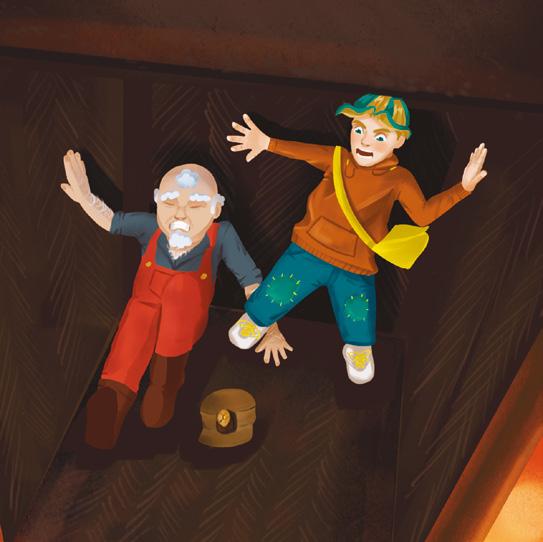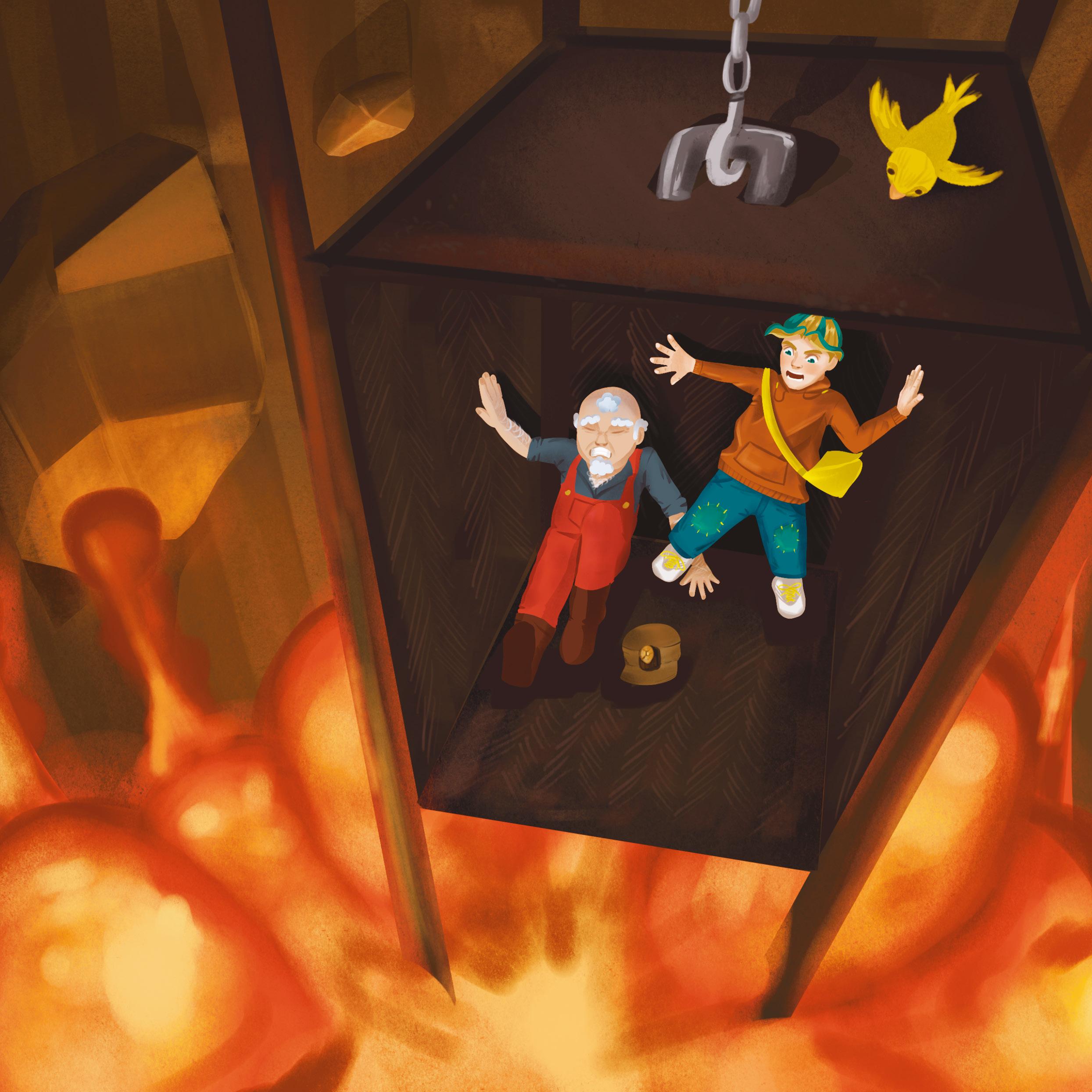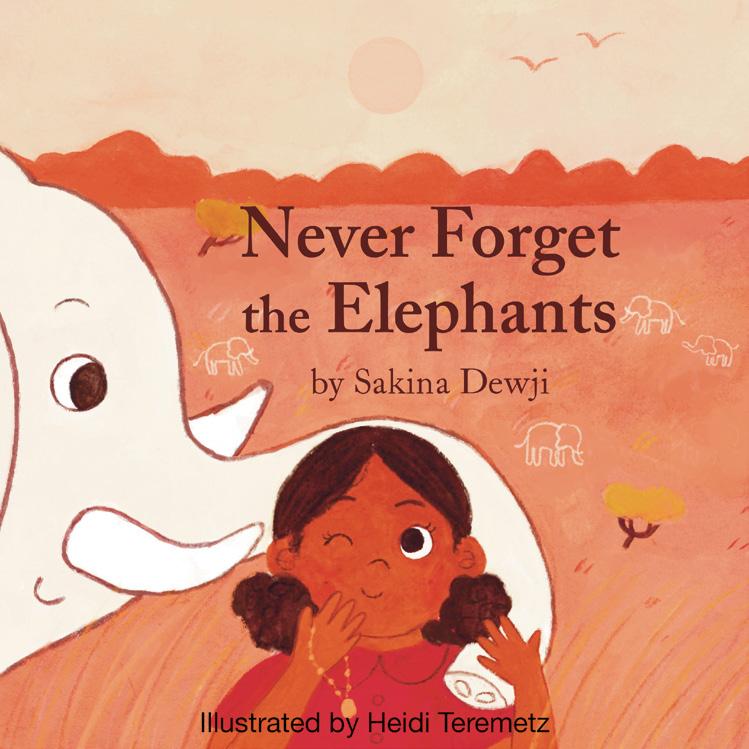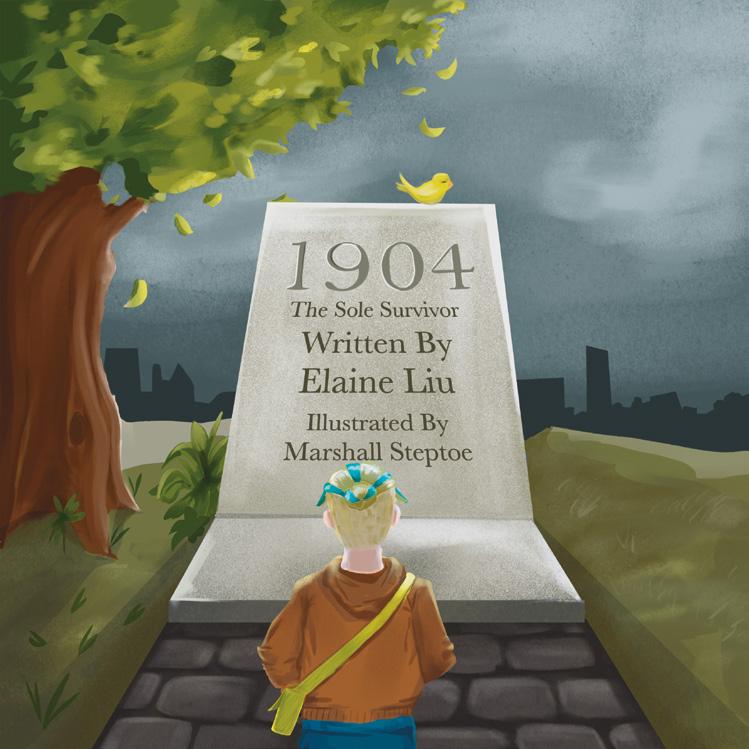1904: The Sole Survivor
Written by Elaine Liu
Illustrated by Marshall Steptoe
A stone silent canary stood on top of the plinth on the memorial, overlooking our town, which listed the names of 44 men killed in the Greenhill Pit explosion, but my great-grandfather’s name was missing.
I looked at the list of places my grandfather had written in his delicate handwriting. I crossed off ‘memorial’. Fat raindrops started to fall from the sky, perfect, I thought, this school project was turning out to be a real bore. We all had to research something from our family history, but in my family, there were no war heroes, explorers or footballers. But my grandfather had sent me on a quest, his list had so far sent me to the library, the chapel, and the memorial. Now I looked at the next place on his list, this time instead of a placename he had sketched a small map. I trudged off, pulling up my hood against the rain.
After hours of climbing, I finally arrived at the X that was shown on the map. I was surrounded by verdant valleys; the view was breathtaking. Weirdly, the X on the map matched a strange etching on the wall of the rocky hill above a cave behind rotten planks. I took in the scenery once more before cramming my body in between the planks, switching on the torch on my phone before plunging into the darkness.
I realised very quickly that this was an old mine and I regretted not charging my phone. In the dimming light of my phone I could make out rusted pickaxes, charred TNT boxes and cobwebs everywhere.
Everything went dark. My phone battery had died. I felt my way around, brushing my hands on the slimy walls taking careful steps. Suddenly, I stumbled, and fell onto the cold ground. As I lifted myself off the ground a sudden wave of dizziness and nausea hit me.
There was an oxidised lift in the shadows. I stepped into the dilapidated lift. As I descended, a cool draught of air whipped up my spine. I heard strange sounds like boots on rocks, creaking, shifting timber and amplified breathing. I thought I was alone. Suddenly, the lights illuminate the dank mineshaft, and someone was already waiting at the foot of the lift, holding a wheelbarrow filled with coal.
“Oi, who are ya?” Wheelbarrow person grunted out. “I’m Rhys.” “New ‘ere ain’t ya? Follow Old Rhys, NOW.”
The air was thick and tasted of sweat and cold rock. Something strange was happening. Glancing around I saw the men and boys were all dressed very differently, no-one was wearing jeans and definitely no-one was wearing Nikes! The TNT boxes were filled with hundreds of waxy sticks of dynamite.
Old Rhys looked like someone I had met before, but I couldn’t place him. It was weird that he had the same name as me.
“What’s the canary for?” I asked, spotting a cage with a yellow bird inside. “Us miners ‘ere don’t know when the gases get too strong, so we take a canary down with us. If it dies, we know it’s time to get out,” he replied in a gruff tone. “Your job is to stand here and watch that canary. The minute it looks a bit ill, you yell.”
He walked off, leaving me and the canary in the flickering lamplight.
Several hours passed. Suddenly I realised something had changed: the bird’s chirping had stopped. It was struggling to breathe. I had to warn them. I ran through the tunnels grabbing Old Rhys by the sleeve. I couldn’t breathe or shout, but I pulled him to the lift as fast as I could. He seemed quite heavy, in shock, before he realised what was happening. As the lift ascended, I heard a man shout “FIRING” and the deadly hiss of the dynamite fuse.
The lift was climbing metre by metre. There was an almighty BANG. Below, I saw the tunnel engulfed in a bright fireball. The ceiling started to cave in. The lift kept climbing, just escaping the brunt of the flame. We stumbled out and I’d never felt so glad it was still raining. I turned around to check on Old Rhys but all I saw was those rotten planks in the same place and the same X etched into them.
I started walking back down the hill trying to figure out what had just happened. Had I just bumped my head and fallen out of consciousness? I put one hand in my pocket and the other to my head. I pulled out the list and from the envelope fell a sepia photograph, it was the face of a man, Old Rhys. I turned over the picture and on the back was written in my grandfather’s delicate handwriting: ‘Rhys Davies, your great grandfather, sole survivor of the Greenhill Pit tragedy, 1904’.
THE END
About Time to Write
ISEB’s 2024 Time to Write competition, launched in celebration of the exam board’s 120th anniversary, was about celebrating the past and looking forward to the future. The innovative creative writing competition was open to all schools everywhere, and asked children of four different age groups to submit short stories written in response to a set theme.
A time machine is found hidden in a cave. Inside, there is a clock with two options: the first, to travel in time 120 years into the past, and the second, to travel in time 120 years into the future. Who finds it, and what happens next?
More than 2,000 children from schools all over the world entered the competition in its first year, with entries shortlisted collaboratively by a pool of judges using cuttingedge adaptive comparative judgement technology, in partnership with RM Compare. This resulted in a reliable, fair and accurate ranking of entries. The top ten stories in each category were reviewed by a panel of judges, including a children’s book author, a children’s book editor from Oxford University Press, a senior researcher from the University of Winchester, and heads of English from Eton College, St Swithun’s School, and St Catherine’s School, Bramley.
To find out more about ISEB’s Time to Write competition, visit write.iseb.co.uk.
ISEB would like to thank RM Compare; the judging panel: Ali Sparkes, Anna Camilleri, Ellen Spencer, Emma Drage, Naomi Anson and Sarah Strachan; sponsors Altec Lansing, AWS, Ingram Micro, Oxford University Press, Scanning Pens and TTS; all who took part in the shortlisting process; and all of the young writers who entered the Time to Write competition.
The four winning stories
A time machine is found hidden in a cave.
Inside, there is a clock with two options: the first, to travel in time 120 years into the past, and the second, to travel in time 120 years into the future. Who finds it, and what happens next?
On a quest to uncover their family history, a boy stumbles and falls into a mineshaft. But things are different there, and he finds himself face to face with an oddly familiar stranger. Will he get back safely, and could it be that his past is a whole lot more interesting than he thought?
The winning story in the category for writers in years 7, 8 and 9 in the 2024 ISEB Time to Write international creative writing competition.
“A very effective slow release of information with a great historical setting.” The Time to Write judging panel.












